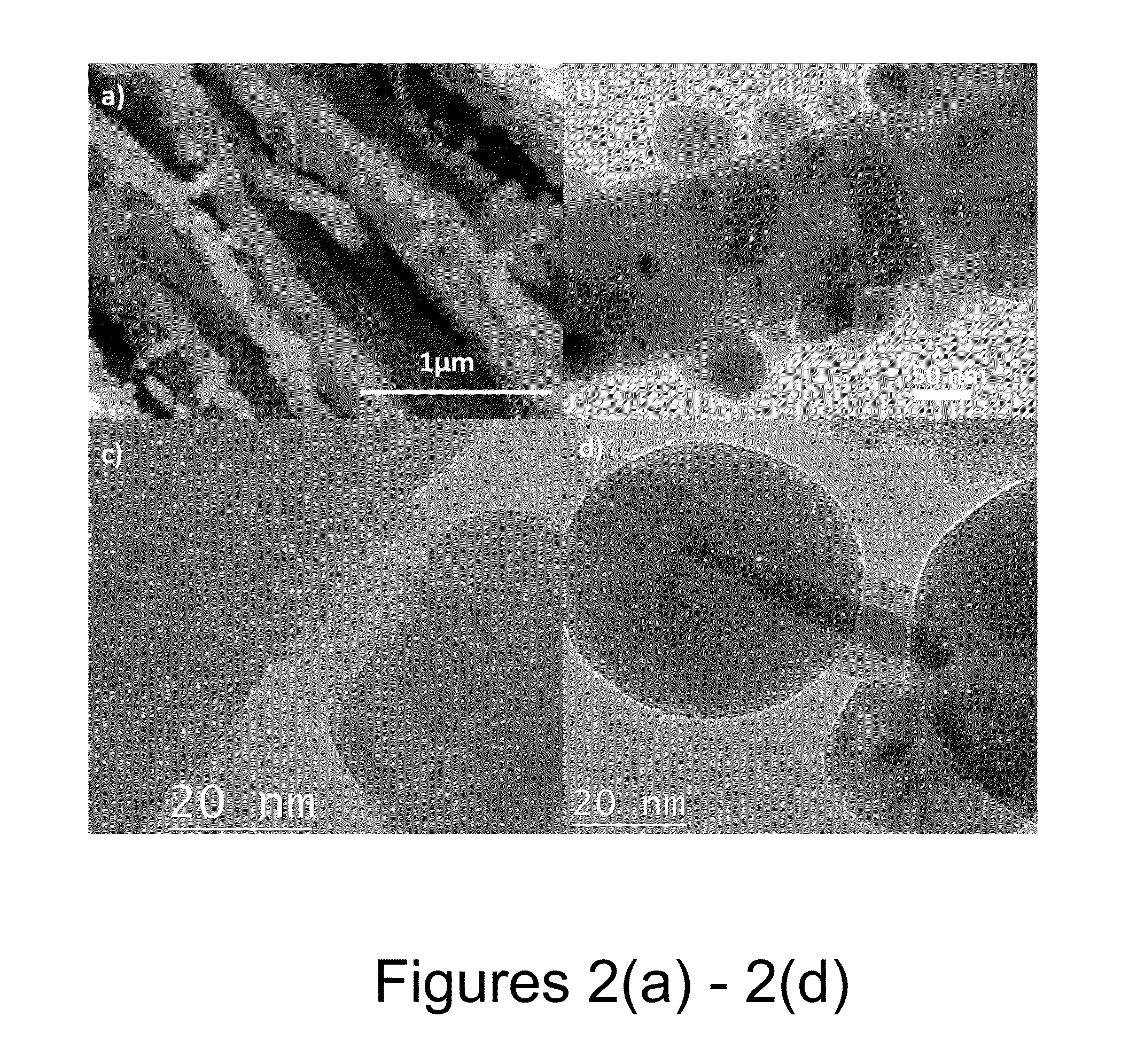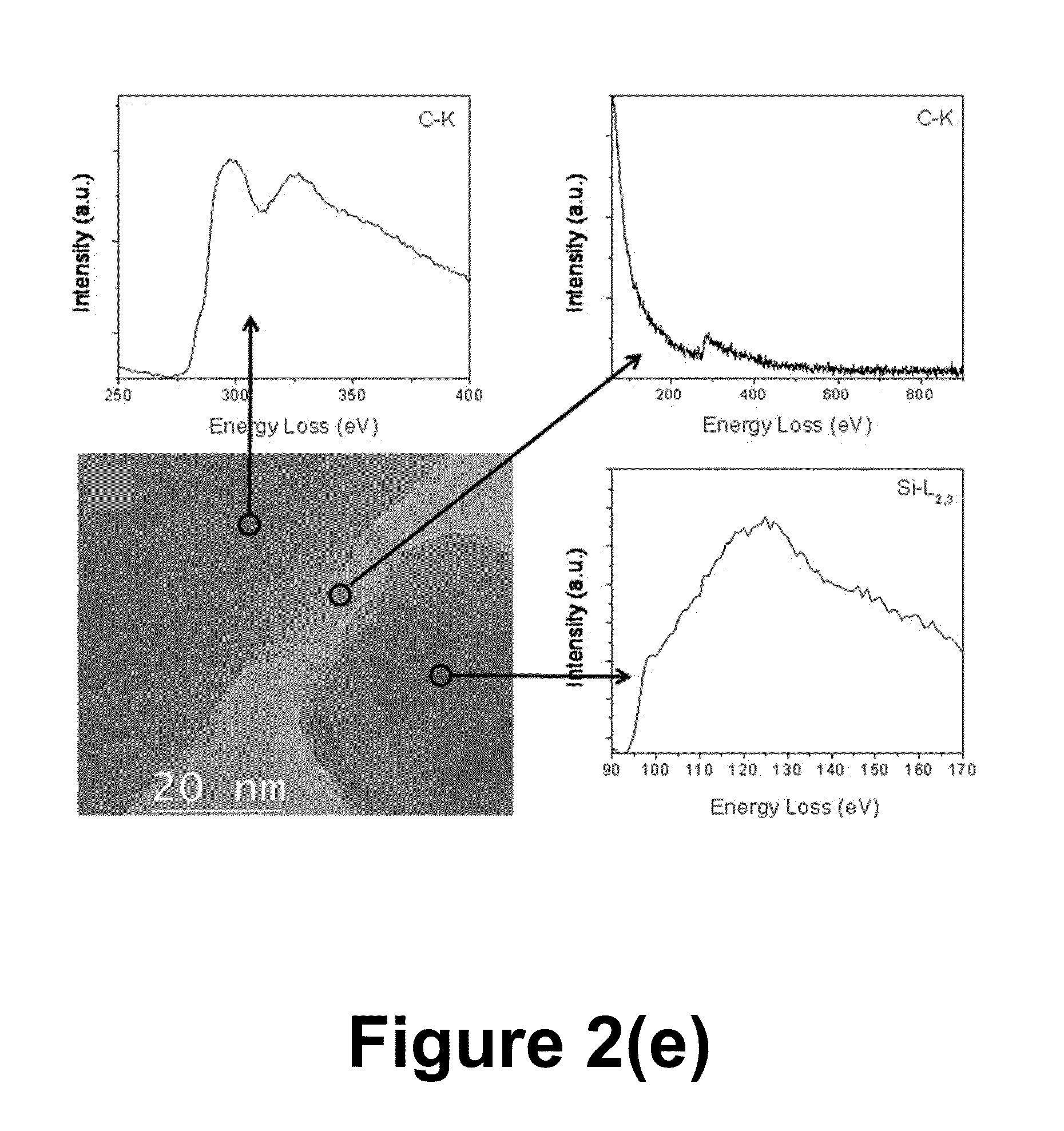Compositions Including Nano-Particles and a Nano-Structured Support Matrix and Methods of preparation as reversible high capacity anodes in energy storage systems
a technology of nanoparticles and support matrix, which is applied in the direction of non-metal conductors, cell components, conductors, etc., can solve the problems of mechanical failure of the electrode, severe limited cyclability of the electrode, and crumbling of the anod
- Summary
- Abstract
- Description
- Claims
- Application Information
AI Technical Summary
Benefits of technology
Problems solved by technology
Method used
Image
Examples
example 1
Growth of CNTs on Bare Quartz Microscopy Slide
[0072]A two-stage CVD reactor comprising liquid and gas injectors was employed for preparing multi-walled carbon nanotubes (MWNTs) on bare quartz microscopy slides inside a quartz tube. About 6.5 mol % of ferrocene was dissolved in xylene to obtain a feed solution with about 0.75 at. % Fe / C ratio, and was injected continuously into the two-stage tubular quartz reactor, which was maintained at a temperature of about 200° C. for pre-heater and about 750° C. for reactor, respectively. Ferrocene sublimes at about 190° C. and xylene has a boiling temperature of about 140° C. The liquid exiting the capillary tube was immediately volatilized and swept into the reaction chamber by a flow of about 750 sccm mixture of ultra-high purity argon (UHP-Ar) with about 10% pure hydrogen. After the reaction, the pre-heater and the furnace were allowed to cool down in flowing argon.
Deposition of Silicon on Pre-Grown Carbon Nanotubes
[0073]Silicon deposition ...
example 1 (
Example 1(a)
Growth of CNTs on Bare Quartz Microscopy Slide
[0083]A two-stage CVD reactor comprising liquid and gas injectors was employed for preparing MWNTs on bare quartz microscopy slides inside a quartz tube. About 6.5 mol % of ferrocene was dissolved in xylene to obtain a feed solution with about 0.75 at. % Fe / C ratio, and was injected continuously into the two-stage tubular quartz reactor including a pre-heater maintained at a temperature of 200° C. and a reactor maintained at a temperature of 750° C. Ferrocene sublimes at about 190° C. and xylene has a boiling temperature of about 140° C. The liquid exiting the capillary tube was immediately volatilized and swept into the reaction chamber by a flow of from about 200 to about 1000 sccm of a mixture of ultra-high purity argon (UHP-Ar) with 10% pure hydrogen. After the reaction, the pre-heater and the furnace were allowed to cool down in flowing argon.
Deposition of Silicon on Pre-Grown Carbon Nanotubes
[0084]Silicon deposition was...
example 2
Growth of Multi-Walled Nanotubes on Inconel Alloy Disk
[0093]A chemical vapor deposition (“CVD”) reactor including a stainless steel bottle as pre-heater was employed for preparing multi-walled nanotubes (“MWNTs”) on an Inconel alloy disk of 1 cm2 inside a quartz tube. Approximately 0.1 g of ferrocene was dissolved in 10 ml of xylene to obtain a feed solution, and was injected continuously into the stainless steel bottle at an injection rate of 0.11 ml / min The stainless steel bottle was maintained at 200° C. for pre-heating, and the reactor was at 770° C. for MWNTs growth. Ferrocene sublimes at about 190° C. and xylene has a boiling temperature of about 140° C. The solution injected into the stainless steel bottle was immediately volatilized and swept into the reaction chamber by a flow of 100 sccm mixture of ultra-high purity argon (“UHP-Ar”) with 10% pure hydrogen. After the reaction, the pre-heater and the furnace were allowed to cool down in flowing argon.
[0094]Silicon deposition...
PUM
| Property | Measurement | Unit |
|---|---|---|
| tube diameter | aaaaa | aaaaa |
| diameter | aaaaa | aaaaa |
| diameter | aaaaa | aaaaa |
Abstract
Description
Claims
Application Information
 Login to View More
Login to View More - R&D
- Intellectual Property
- Life Sciences
- Materials
- Tech Scout
- Unparalleled Data Quality
- Higher Quality Content
- 60% Fewer Hallucinations
Browse by: Latest US Patents, China's latest patents, Technical Efficacy Thesaurus, Application Domain, Technology Topic, Popular Technical Reports.
© 2025 PatSnap. All rights reserved.Legal|Privacy policy|Modern Slavery Act Transparency Statement|Sitemap|About US| Contact US: help@patsnap.com



